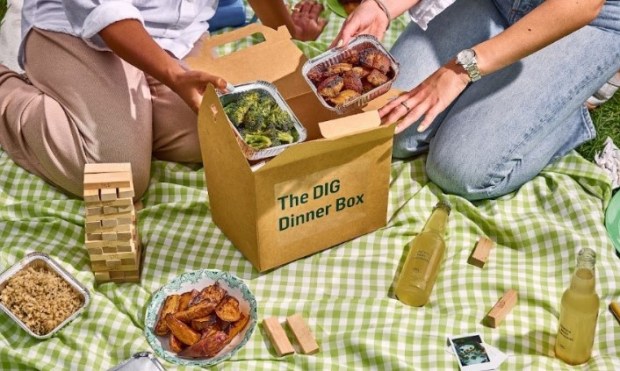DIG Launches Dinner Box as Ready-to-Eat Providers Seize Restaurant Occasions

As ready-to-eat meal options gain share from restaurants, DIG has become the latest eatery to take an “If you can’t beat ’em, join ’em” approach.
The New York-based fast-casual chain announced Tuesday (July 18) the launch of meal boxes, each featuring different entrée components and side dishes, serving four for $48.
“At DIG, our team understands the challenges when it comes to weeknight dinners, whether that be accessibility, time constraints or affordability,” Tracy Kim, the brand’s CEO, said in a statement. “With the DIG Dinner Box, we aim to alleviate the stress and time-consuming aspects of meal preparation, by providing a sustainable, fresh and affordable alternative to takeout or dine-in.”
These meals are less expensive than eating in the restaurant, which costs mid-teens per person, but the brand’s assertion that these boxes offer an “affordable” solution may be a stretch.
Overall, PYMNTS research reveals that more consumers are turning to ready-to-eat meal options on occasions where previously they may have ordered in from a restaurant. According to data from the May edition of the Connected Dining study, “Connected Dining: Ready-to-Eat Meals Are Eating Restaurants’ Lunch,” for which we surveyed more than 2,300 U.S. consumers in April, the majority of consumers (57%) now purchase ready-to-eat meals at least once a month, and 28% do so once a week or more.
Yet most consumers are not getting these meals through direct-to-consumer (D2C) channels or from restaurants. The study also reported that 65% of those who purchased ready-to-eat meals in the last month bought them from a grocery store, while only 17% had them delivered.
Still, given that quality is a top-of-mind concern for ready-to-eat meal customers, it is possible that they would be willing to shift channels for a good enough option. Survey results revealed that 69% of ready-to-eat purchasers have been increasing their purchases of ready-to-eat meals because the quality of options available has improved, and a plurality of these consumers cited quality as their single most important reason for purchasing more.
Noting this shift to ready-to-eat, an increasing number of restaurants, as well as grocers and food companies, have been looking to capture consumers’ prepared meals spending. Panera Bread, for instance, is incentivizing purchase of its grocery products this summer by offering $5 credits for restaurant items if consumers spend $20 on the brand’s consumer-packaged goods (CPG) in stores. Plus, earlier this year, casual dining chain Red Lobster announced the launch of new frozen meals.
Moreover, grocers have been adding more prepared food options in an effort to gain share from restaurants, and CPG brands have throwing their hats in the ring as well. Earlier this month, confectionery giant Mars’ more health-focused foods division, Mars Food & Nutrition, announced its acquisition of meal kit company Kevin’s Natural Foods, which sells its products through its direct-to-consumer (D2C) online shop as well as at brick-and-mortar retailers.
Yet not all D2C meal delivery bets pay off. In the fall, Nestlé bailed on its Freshly prepared meals business, offloading the company just a month before it ceased deliveries entirely.

